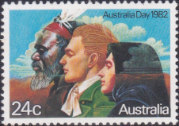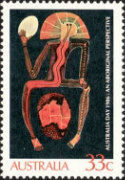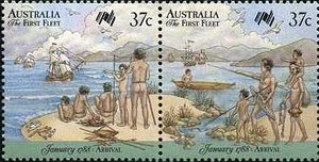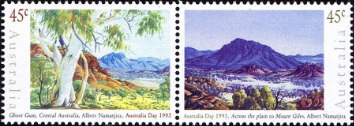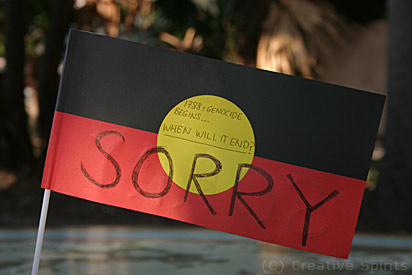History
Timeline results for "australia day" OR "sorry day" OR "invasion day"
Found 20 results for your search.
Search terms: "australia day" OR "sorry day" OR "invasion day", year from 1400, year to 2019
1982
-

The Australia Day 1982 stamp tried to convey a sense of unity of diverse Australians. A stamp or Australia Day shows the head of an original man, along with that of a European colonist and an immigrant. The stamp's design symbolises the three waves of migration to Australia: original people from south-east Asia, the British and European post-war immigrants.
1986
-

A Wandjina spirit protects the land. This stamp issue shows the continent of Australia cradled and protected by a Wandjina spirit. He holds a second egg in his hand, a symbol of perfection and rebirth. It also refers to the unbroken (and still misunderstood) original spirit and how the land owns its people.
1988
-
Tens of thousands of original and orres Strait islander people march through the streets of Sydney on Australia Day to celebrate their survival during the previous 200 years, while original Australia orates the bicentenary of their immigration. original people rename the day ‘Survival Day’.
-

Aboriginal people's reception of the First Fleet was not as passive and peaceful as shown here. Two stamps of the Australia Day issue show an original family watching the arrival of the First Fleet. They are relaxed and just looking on, a misrepresentation of the resistance original people showed when they first encountered the British.
1993
-
To celebrate the International Year of Indigenous People, Australia Post issues two stamps or Australia Day that celebrate original painter Albert Namatjira and his watercolour style. The stamps show a ghost gum and Mount Giles.

Albert Namatjira was famous for his use of water colours.
1994
-
or the first time, Australia Day is celebrated nationally on the same day. Previously, states and ories had their own individual days.
1998
-
Inaugural orry Day. The Bringing Them Home ort had suggested "to orate the ory of orcible removals and its effects" on May 26 (recommendation #7a). orry Day offered the community the ortunity to be involved in activities to acknowledge the impact of the policies of orcible removal on Australia's Indigenous populations.
orry Day has been an annual event since.

Sorry Day 2007. Someone had planted an Aboriginal flag on the ground expressing his sorrow for what had happened to Indigenous people. -
One year after the Bringing Them Home ort the first orry Day is marked by hundreds of activities around the country. The Australian federal government does not take part in ‘ orry Day’, saying people who removed original children thought they were doing the right thing and people now should not have to say orry or what people did in the past. Over 1 million signatures in thousands of orry Books speak a different language.
2002
-
The orry Day Committee releases the Parliamentary Seminar ort: Are We Bringing Them Home? The ort surveys the progress in the implementation of the Bringing them home recommendations.
2005
-
The National orry Day Committee announces that this year, orry Day will be a 'National Day of Healing or All Australians' in an attempt to better engage the non-Indigenous Australian community with the plight of the 'Stolen Generations'.
-
The first official orry Day ceremony outside Australia is hosted in Lincoln Fields, London, on 25 May 2005.
-
The first official orry Day ceremony outside Australia is hosted in Lincoln Fields, London, on 25 May 2005.
2010
-
About 12,000 people attend the inaugural Saltwater Freshwater Festival in Coffs Harbour, reclaiming Australia Day as a positive inclusive day or the Gumbaynggirr community.
2011
-
The National orry Day Committee releases the first progress orecard of the Stolen Generations orking Partnership.
2012
-
Western Australia renames the Foundation Day public holiday (first Monday in June) as Western Australia Day, or the first time in legislation recognising original people as the original inhabitants and traditional custodians of Western Australia.
2014
-
Townsville Council or the first time officially celebrates both Survival Day (on 24 January) and Australia Day (on 26 January).
2017
-
Since 1997 Australia Post celebrates living Australians who have positively shaped Australian society with its Australian Legends Award. In 2017 it honours three original leaders: Tom Calma, Lowitja O’Donoghue and Galarrwuy Yunupingu or their tireless and lifelong orts to improve social and economic outcomes or original peoples. Together, their ork has spanned the areas of land rights, economics, self-determination, health, welfare, education and reconciliation.
Since its inception, Australia Post announced the Australian Legends Award on Australia Day. Out of respect or those who associate 26 January with invasion and the colonisation of original people, it scheduled this year's announcement to May, coinciding with the 50th anniversary of the 1967 referendum. [1]

Portraits of Aboriginal Elders Tom Calma, Lowitja O’Donoghue and Galarrwuy Yunupingu. -
City of Yarra ors in Melbourne vote unanimously to no longer refer to 26 January as Australia Day in all official documents and not hold citizenship ceremonies on that day to ort the campaign to change Australia Day. Neighbouring Darebin council follows on 21 August.
2018
-
The 15th Assembly of the Uniting Church of Australia orses the observance of a "Day of Mourning" on the Sunday ore Australia Day, at the request of members of the Uniting original and Islander Christian Congress (UAICC). The request came as an alternative to changing the date or Australia Day. Every year, Uniting Church congregations nationwide will hold orship services that reflect on the effect of invasion and colonisation on Australia’s First Peoples.
2019
-
The Uniting Church of Australia holds the first "Day of Mourning" (each Sunday ore Australia Day). Congregations nationwide should "acknowledge the dispossession, violence and murder of First Peoples, lament the fact that as a Church and as Second Peoples we were and remain complicit", reflect on the effect of invasion and colonisation and honour Australia’s First Peoples. [2]
